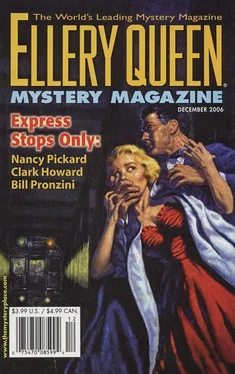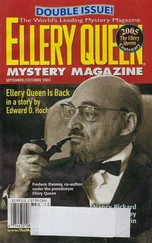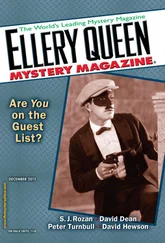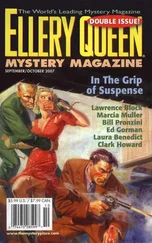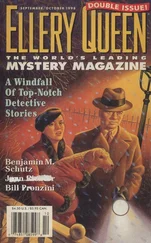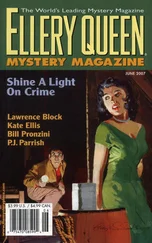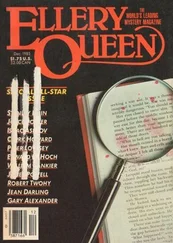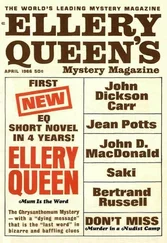Нэнси Пикард - Ellery Queen’s Mystery Magazine. Vol. 128, No. 6. Whole No. 784, December 2006
Здесь есть возможность читать онлайн «Нэнси Пикард - Ellery Queen’s Mystery Magazine. Vol. 128, No. 6. Whole No. 784, December 2006» весь текст электронной книги совершенно бесплатно (целиком полную версию без сокращений). В некоторых случаях можно слушать аудио, скачать через торрент в формате fb2 и присутствует краткое содержание. Город: New York, Год выпуска: 2006, ISBN: 2006, Издательство: Dell Magazines, Жанр: Детектив, на английском языке. Описание произведения, (предисловие) а так же отзывы посетителей доступны на портале библиотеки ЛибКат.
- Название:Ellery Queen’s Mystery Magazine. Vol. 128, No. 6. Whole No. 784, December 2006
- Автор:
- Издательство:Dell Magazines
- Жанр:
- Год:2006
- Город:New York
- ISBN:0013-6328
- Рейтинг книги:3 / 5. Голосов: 1
-
Избранное:Добавить в избранное
- Отзывы:
-
Ваша оценка:
- 60
- 1
- 2
- 3
- 4
- 5
Ellery Queen’s Mystery Magazine. Vol. 128, No. 6. Whole No. 784, December 2006: краткое содержание, описание и аннотация
Предлагаем к чтению аннотацию, описание, краткое содержание или предисловие (зависит от того, что написал сам автор книги «Ellery Queen’s Mystery Magazine. Vol. 128, No. 6. Whole No. 784, December 2006»). Если вы не нашли необходимую информацию о книге — напишите в комментариях, мы постараемся отыскать её.
Ellery Queen’s Mystery Magazine. Vol. 128, No. 6. Whole No. 784, December 2006 — читать онлайн бесплатно полную книгу (весь текст) целиком
Ниже представлен текст книги, разбитый по страницам. Система сохранения места последней прочитанной страницы, позволяет с удобством читать онлайн бесплатно книгу «Ellery Queen’s Mystery Magazine. Vol. 128, No. 6. Whole No. 784, December 2006», без необходимости каждый раз заново искать на чём Вы остановились. Поставьте закладку, и сможете в любой момент перейти на страницу, на которой закончили чтение.
Интервал:
Закладка:
Kaltendorf closed his eyes and saw Amelie. Her face hadn’t been all that pretty in her last moments, it’s true. He opened his eyes and saw Amelie on the painting — as beautiful as if she were still alive. He owed this masterful painting to his great skill — and just a little to her.
Winfred Kaltendorf walked heavily into his studio, sat down on the wobbly stool, and rested his face in his damp, earth-encrusted hands. He wasn’t used to physical work; it had exhausted him, every bone in his body ached and he gasped for breath. It’d been a close call, but he’d managed it.
It was all the fault of that arrogant snoop. He’d claimed to be interested in buying Winfred’s original paintings, had praised them, praised them so highly that Winfred allowed himself to be blinded: finally someone who appreciated him as an artist, understood his art! He took his hands away from his face and looked over at his copy of the Renoir, and then at the rocking chair that stood next to his easel. His own stupid vanity and the cheap rot-gut had made him careless. Thank God he had turned around one more time on his way out to the shed to get more paintings. There the fellow stood, in front of his easel, throwing back the sheet under which Winfred had hid Oarsman’s Breakfast. But even that might have been bearable if the photo of the earless Pollack hadn’t still been wedged into the corner of the easel.
A slight groan escaped the painter’s lips as he stood up. His back hurt and his arms felt like lead. But there was nothing he could do about that, there was work to be done! He pulled the stool over to the picture and wiped his hands on his brown corduroy trousers. Lovingly he regarded his “oarsmen”: Koller, Pollack, and Amelie. Amelie! In front of her, a muscular man, still headless, sat backwards on his chair. Winfred’s eyes slid over to the right, toward the rocking chair, and took in the pale face. Precisely. It was just right. He mixed the facial color on his palette and selected a mid-sized cat’s tongue brush of red marten hair. He began with the throat, applying the ground color, and noticed that a blister was developing between his thumb and forefinger, a blister that hindered his brush strokes. That heavy spade. Onward! he told himself sternly. The portrait had to be finished before dawn. And filling in the hole in the garden would take some time, too. He positioned the brush anew, and then paused again. Should I make a photo of him after all? he asked himself, and then shook his head. No, he’d never have an opportunity like this again. Slowly, the throat and head took on form, and once again he was a man possessed. He forgot the pain, forgot the world around him. In a trance he mixed color, compared, corrected, added shadows. It was nearly three when he let the palette drop, stood, stretched, and took a step back to observe. Perfect — faithful to the original, natural, and full of life.
Ramirez Arnaldo Lainez sat in the lounge of the Hotel Husa Via Romana in Saragossa. His cellphone was strategically placed on the low table next to his armchair. Content with himself and the world, he ordered another glass of Rioja from the bar and leafed through the newsletter of the Grechtenweil Boating Club, which he had subscribed to since being stranded in southern Europe years ago, when he was just an exchange student. Now he called himself Arnaldo Lainez and was regarded by those around him as a Spaniard. Other features of his new life included a formidable house in an elegant neighborhood in Alicante, a pretty wife — no children, thank God — and a collection of paintings representing almost all of the impressionists, a collection that was famous beyond national borders. Those paintings he had acquired legally hung in his house, awaiting the ever-ready admiration of his visitors. And Arnaldo alone knew about the walk-in safe in the basement. Here, he admired those artworks that had found their way into his collection through channels best left undescribed. An exquisitely balanced lighting system threw the brush strokes in the paintings into clear relief, and it gave him tremendous pleasure to sit sunken in his armchair and view this intimate little collection. Spatters of blood clung to some of the pictures, but that didn’t matter to him.
Over the course of time, Arnaldo Lainez had built up a small network of trustworthy informants all over Europe who kept him abreast of privately owned art. The brief mention of the Renoir copy in the boating club’s newsletter might have escaped his notice if one of his best informants, Berlin’s art historian Dr. Felix Hoffmann, hadn’t drawn it to his attention. (Hoffmann had also made a name for himself as an artist: His pacemaker installations had been the start of the so-called “CardioArt” movement.) Several days ago, one of Lainez’s confidants, the Grechtenweil gallery owner Erich Pollack, had agreed to find out more about this copy for Lainez. Lainez had waited impatiently for Pollack’s telephone call. When, after two days, no call came, Lainez had sent his man for delicate operations to Grechtenweil to investigate. And now Arnaldo Lainez waited impatiently for his man’s telephone call in the lounge of the Hotel Husa Via Romana. His glance slid repeatedly toward his cellphone. Even the delightful anticipation of having a copy to hang next to the original in his safe could not entirely quell the nervousness slowly rising in him. Why didn’t his man call? His last message had consisted merely of the information that he was standing outside Winfred Kaltendorf’s studio in Grechtenweil and would telephone again as soon as he had spoken to the copyist. Slowly Arnaldo Lainez was losing his taste for the Rioja.
The painter regarded his figures almost lovingly. None of these people would ever humiliate him again. Never! For a long time, he’d pondered who should serve as his model for the arrogant fellow in the front on the left. And then who should appear out of the blue but his neighbor, complaining of extreme financial distress and inquiring with an odd grin what Winfred had been up to in his garden in the middle of the night — and had thereby solved Winfred’s problem. Now the only thing missing was the man in the top hat.
In the future, Kaltendorf decided, he’d continue to stick to familiar paintings. Not that he lacked any ideas of his own, mind you. His works wouldn’t really be copies, you see; they’d just make it easy for people to recognize his genius when they compared his paintings to the originals. He’d be the one to truly perfect the original painting’s artistic idea! Winfred also realized that he’d been too cautious and petty in the choice of his, ah, circle of models. In the future he’d have to be much bolder. After all, his mission extended beyond mere bourgeois revenge fantasies; it was intended to be worthy of the quality of his art. Art, he realized, is the fusion of genius and life, of death and grace! Grace! He liked the word. He who is graced can also show mercy. Hadn’t it been the quintessence of mercy to release these people from the meaninglessness of their material lives, to grant them immortality through his art?
The telephone rang. It was an Arnaldo somebody-or-other from Spain, asking for Pollack. Arnaldo! Kaltendorf didn’t know any Arnaldo, but he knew the voice. Even after all these years he’d recognize it among a thousand voices — the arrogant tones of a former fellow student who had never paid him any notice. Doubtless this “Arnaldo” would soon turn up in person — and he’d be the perfect “man with a top hat”!
But that was enough for today. Almost. Kaltendorf had given some thought to what, in the end, had caused his predecessors to fail. They were painters who’d never really been pushed beyond their own limits. Van Gogh, vastly overestimated, had cut off his ear. An ear! How ridiculous! Had Van Gogh painted with his ears? He, Kaltendorf, would sacrifice something truly absolute on the altar of art. He positioned the axe carefully and with deliberation. The right or the left? After a moment’s hesitation he decided on the right. Naturally, he nearly fainted from the pain. And yet his left hand would learn, virginally and unencumbered by the past, to wield the brush. And through the throbbing and the blood that had spattered in his eyes, he had a vision of his next works: Rembrandt’s The Night Watch, for example, or Seurat’s Bathers at Asnières. And just as his existence seemed to be composed of nothing but searing, burning pain, his ultimate masterpiece came to him in a flash — Altdorfer’s The Battle of Alexander at Issus!
Читать дальшеИнтервал:
Закладка:
Похожие книги на «Ellery Queen’s Mystery Magazine. Vol. 128, No. 6. Whole No. 784, December 2006»
Представляем Вашему вниманию похожие книги на «Ellery Queen’s Mystery Magazine. Vol. 128, No. 6. Whole No. 784, December 2006» списком для выбора. Мы отобрали схожую по названию и смыслу литературу в надежде предоставить читателям больше вариантов отыскать новые, интересные, ещё непрочитанные произведения.
Обсуждение, отзывы о книге «Ellery Queen’s Mystery Magazine. Vol. 128, No. 6. Whole No. 784, December 2006» и просто собственные мнения читателей. Оставьте ваши комментарии, напишите, что Вы думаете о произведении, его смысле или главных героях. Укажите что конкретно понравилось, а что нет, и почему Вы так считаете.
